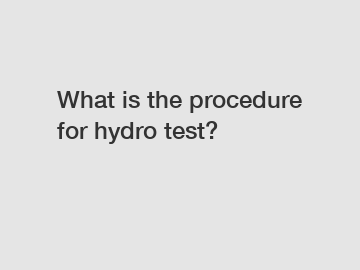You will get efficient and thoughtful service from SUNCENTER.
Hydrostatic testing is a crucial procedure in the oil and gas industry, as well as in various other industries that require pressure vessels and piping systems to be inspected for their integrity and safety. .
In simple terms, hydrostatic testing involves pressurizing a vessel or pipe with water to a predetermined pressure level, typically 1.5 times the design pressure, to ensure that it can withstand the maximum pressure it is expected to endure during operation.

The procedure for hydro testing is a meticulous process that requires careful planning, preparation, and execution. It is important to follow proper procedures to ensure the safety of personnel and equipment involved in the testing process.
Here's a step-by-step guide on how hydro testing is typically carried out:
1. Pre-Test Preparation:
Before initiating the hydro test, it is essential to conduct a thorough inspection of the vessel or pipe to ensure that it is clean and free of any debris or foreign material that could affect the test results. All connections, valves, and fittings should be checked for leaks or defects.
2. Test Setup:
The vessel or pipe is filled with water, ensuring that all air is removed from the system to prevent air pockets that could compromise the test results. The test pressure is calculated based on the design pressure of the vessel or pipe, typically 1.5 times the design pressure.
3. Pressurization:
Once the vessel or pipe is filled with water, a pump is used to gradually increase the pressure inside the system to the designated test pressure. The pressure is held steady for a predetermined duration, usually for a minimum of 30 minutes, to allow for any potential leaks or weaknesses to be identified.
4. Inspection:
During the pressurization phase, inspectors will closely monitor the system for any signs of leakage, deformation, or other anomalies. Any leaks or defects detected during the test must be immediately addressed and rectified before proceeding further.
5. Releasing Pressure:
After the designated holding period, the pressure is gradually released from the system, and the water is drained from the vessel or pipe. The system is then thoroughly inspected for any signs of damage or issues that may have occurred during the test.
6. Documentation:
A detailed report of the hydro test, including test pressure, duration, results, and any findings or issues identified during the test, must be compiled and maintained for future reference. This documentation is important for ensuring compliance with regulatory requirements and for tracking the integrity of the system over time.
While the procedure for hydro testing may seem straightforward, it is critical to have experienced and skilled personnel overseeing the process to ensure that the test is conducted safely and accurately. Any deviations from the proper test procedures could result in faulty test results or, worse, catastrophic failures during operation.
In conclusion, hydrostatic testing is a vital process in ensuring the safety and reliability of pressure vessels and piping systems in various industries. By following proper procedures and guidelines, companies can maintain the integrity of their equipment and prevent potentially disastrous accidents. It is important to invest in the necessary resources and expertise to conduct hydro tests effectively and safely.
View Details
Contact us to discuss your requirements of hydraulic hose testing machine. Our experienced sales team can help you identify the options that best suit your needs.


Comments
Please Join Us to post.
0